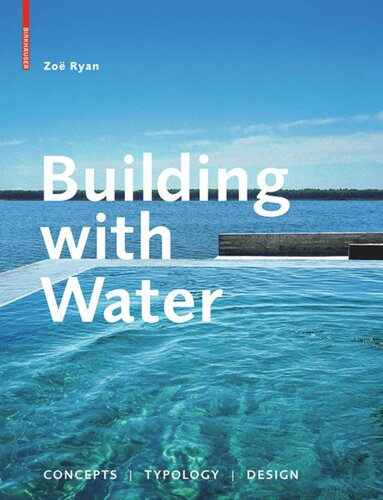

Most ebook files are in PDF format, so you can easily read them using various software such as Foxit Reader or directly on the Google Chrome browser.
Some ebook files are released by publishers in other formats such as .awz, .mobi, .epub, .fb2, etc. You may need to install specific software to read these formats on mobile/PC, such as Calibre.
Please read the tutorial at this link: https://ebookbell.com/faq
We offer FREE conversion to the popular formats you request; however, this may take some time. Therefore, right after payment, please email us, and we will try to provide the service as quickly as possible.
For some exceptional file formats or broken links (if any), please refrain from opening any disputes. Instead, email us first, and we will try to assist within a maximum of 6 hours.
EbookBell Team

5.0
28 reviewsWater als an element in architecture
Water has been an important topic in architecture and urban planning for years. The revitalization of the waterfront has been a prevalent trend in cities around the world. On the other hand, architecture also had to respond to the threat of floods.
The theme of Building with Water is the use of water in architecture. It presents buildings that explicitly refer to water in their design and form. It establishes a typology of building by the water: residential structures, recreation facilities, industry and infrastructure, buildings for culture and art. The various design parameters are explored in four essays. Subsequently, twenty-two international projects are presented, organized according to their locations by a river, a lake or the sea. The authors’ concern is not to show luxurious buildings in privileged locations but rather presenting projects that seriously grapple with the main criterion of the location—namely, water—in an ecologically sustainable way and respond to it with their design.
Wasser ist seit Jahren ein wichtiges Thema in Architektur und Städtebau. «Building with Water» thematisiert die Verarbeitung von Wasser im architektonischen Entwurf; es werden Bauten vorgestellt, die sich in ihrer Gestaltung und Form ausdrücklich auf Wasser beziehen. Eine Typologie des Bauens am Wasser wird erstellt: Wohnbauten, Verkehrs- und Industriebauten, Bauten für Kultur und Freizeit. Ebenso werden einleitend klassische Beispiele des Bauens am/im/auf dem Wasser gezeigt, wie etwa Château de Chenonceaux an der Loire, Falling Water in Pennsylvania von Frank Lloyd Wright oder das Salk Institute in La Jolla,Kalifornien, von Louis I. Kahn. Geordnet nach ihren Standorten am Fluss, See oder Meer, werden dann etwa 20 internationale Projekte vorgestellt. Es geht den Autoren nicht darum, luxuriöse Bauten an privilegierten Plätzen zu zeigen, sondern Projekte darzustellen, deren Entwurf sich ernsthaft und ökologisch verträglich mit dem Hauptkriterium des Standortes – nämlich Wasser – auseinandersetzt und sich gestalterisch darauf bezieht
The renaissance of water as an element in architecture and urban planning
Numerous stimuli for the practice of design